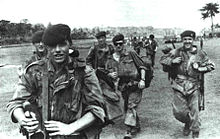
A paratrooper or military parachutist is a soldier trained to conduct military operations by parachuting directly into an area of operations, usually as part of a large airborne forces unit. Traditionally paratroopers fight only as light infantry armed with small arms and light weapons, although some paratroopers can also function as artillerymen or mechanized infantry by utilizing field guns, infantry fighting vehicles and light tanks that are often used in surprise attacks to seize strategic positions behind enemy lines such as airfields, bridges and major roads.
Operation Cooney was the deployment of elements of the 4ème Bataillon d'Infanterie de l'Air - the 4th Free French Parachute Battalion - also known as 4th Special Air Service.

The 2nd Foreign Parachute Regiment is the only airborne regiment of the Foreign Legion in the French Army. It is one of the four infantry regiments of the 11th Parachute Brigade and part of the spearhead of the French rapid reaction force.

The 1st Marine Infantry Parachute Regiment or 1er RPIMa is a unit of the French Army Special Forces Command, therefore part of the Special Operations Command.

The 3rd Marine Infantry Parachute Regiment is one of the airborne force regiments of the Troupes de Marine. It is heir to the 3rd Colonial Commando Parachute Battalion created in 1948 and the 3rd Colonial Parachute Regiment. The regiment is part of the 11th Parachute Brigade.

The 6th Marine Infantry Parachute Regiment is an airborne infantry unit of the French Army.
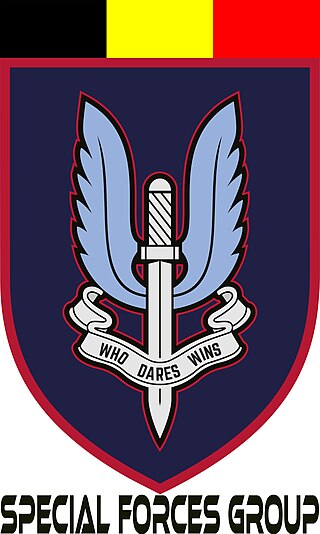
The Special Forces Group is the special forces unit in the Land Component of the Belgian Armed Forces.
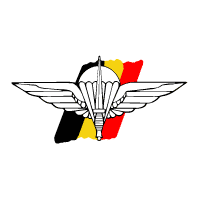
The Special Operations Regiment is a special operations force of the Land Component of the Belgian Armed Forces. Its headquarters is located in Heverlee. It was known as the Light Brigade until 3 July 2018 when it was renamed and transformed into its current form.

The Action Division, commonly known by its predecessor's title Action Service is a division of France's Directorate-General for External Security (DGSE) responsible for planning and performing clandestine and covert operations including black operations. The core specialisations of the Action Division are sabotage, destruction of materiel, assassination, detaining/kidnapping, interrogation with and without using torture, infiltration/exfiltration of persons into/from hostile territory and hostage rescue.

The 5th Special Air Service was the only tier one Belgian special forces during World War II. It consisted entirely of Belgian volunteers. It saw action as part of the SAS Brigade in Normandy, Northern France, Belgium, the Netherlands and Germany. Initially trained in artillery observer, commando style raids, CQB/CQC, gathering military intelligence, irregular warfare, long-range penetration, parachuting, and special reconnaissance, they converted to motorized reconnaissance on armored jeeps. They were the first Allied unit to set foot onto Belgian soil and the first to cross the Siegfried line, albeit accidentally.
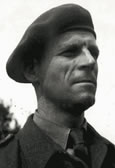
Lieutenant-Colonel Dr. (Dent.) Edouard "Eddy" Blondeel was the wartime commander of the Belgian 5th SAS during World War II. Following the war he was first Commanding Office of the 1st Regiment of Parachutists. He retired from the army in 1947 to work as an engineer with Wiggins Teape.

The Para-Commando Brigade was an elite force in the Belgian Land Component, consisting of two paracommando battalions, the Special Forces Group and a support unit of the Communication & Information Systems Group (CIS). In 2003, its name was changed to the Light Brigade. On 3 July 2018, the Light Brigade was renamed and transformed into the Special Operations Regiment.
The 2nd Commando Battalion is a one of four airborne forces battalion unit of the Belgian Land Component and part of the 'Special Operations Regiment', which specialized in air assault and airborne operations, amphibious warfare, combat patrol, commando style raids, irregular warfare, long-range penetration, special operations, and special reconnaissance. Its regimental traditions, including the name "Commando" and the green beret, were adopted from the Belgian soldiers who served in No. 10 (Inter-Allied) Commando during the Second World War.

The 3rd Parachute Battalion is a one of four airborne forces battalion unit of the Belgian Land Component and part of the 'Special Operations Regiment', which specialized in air assault and airborne operations, combat patrol, commando style raids, irregular warfare, long-range penetration, special operations, and special reconnaissance. It carries on the regimental traditions of the Belgian Korean War volunteers.
The 4th Commando Battalion was a one of four airborne forces battalion unit of the Belgian Army and part of the Para-Commando Brigade, which specialized in airborne operations, combat patrol, commando style raids, irregular warfare, long-range penetration, special operations, and special reconnaissance. It is based in the Belgian colonies of Congo and Rwanda-Urundi between 1959 until its disbandment in 1962, following the independence of Belgium's last African colony. In the 1970s, the unit was revived as 4th (Reserve) Commando Battalion before it was finally disbanded in 1979.

The Royal Lao Army Airborne was composed of the élite paratrooper battalions of the Royal Lao Army (RLA), the land component of the Royal Lao Armed Forces, which operated during the First Indochina War and the Laotian Civil War from 1948 to 1975.
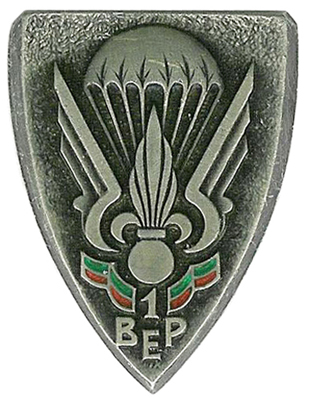
The 1st Foreign Parachute Battalion was a parachute battalion of the Foreign Legion formed from the Parachute Company of the 3rd Foreign Infantry Regiment.

The 2nd Parachute Chasseur Regiment or 2e RCP, is one of the most decorated French units of the Second World War, the only land unit awarded the red fourragère in that war, including six citations at the orders of the armed forces. The French Navy 1500-ton class submarine Casabianca also accumulated six citations at the orders of the armed forces and therefore its crewmen were entitled to wear the same fourragère.
